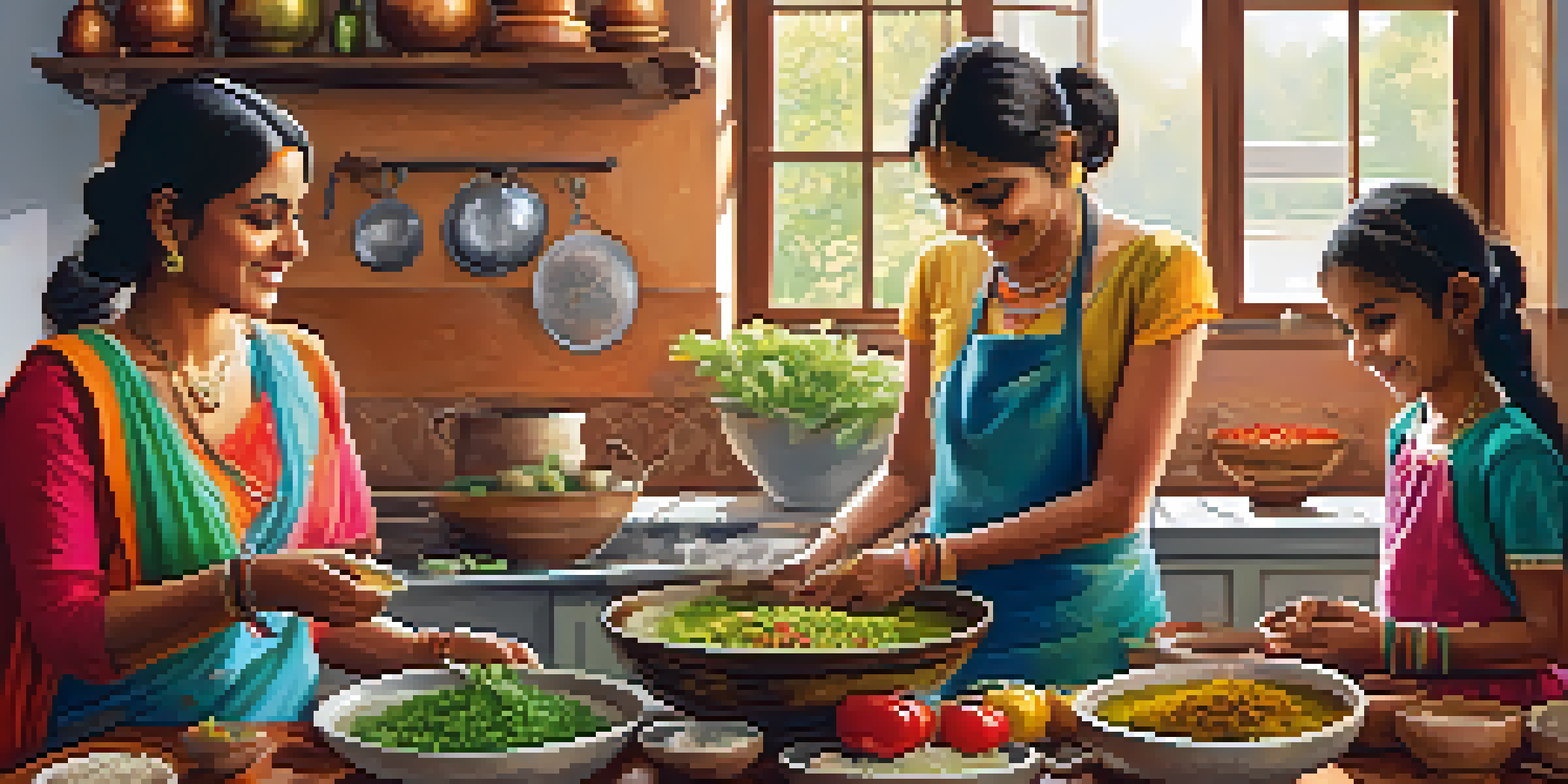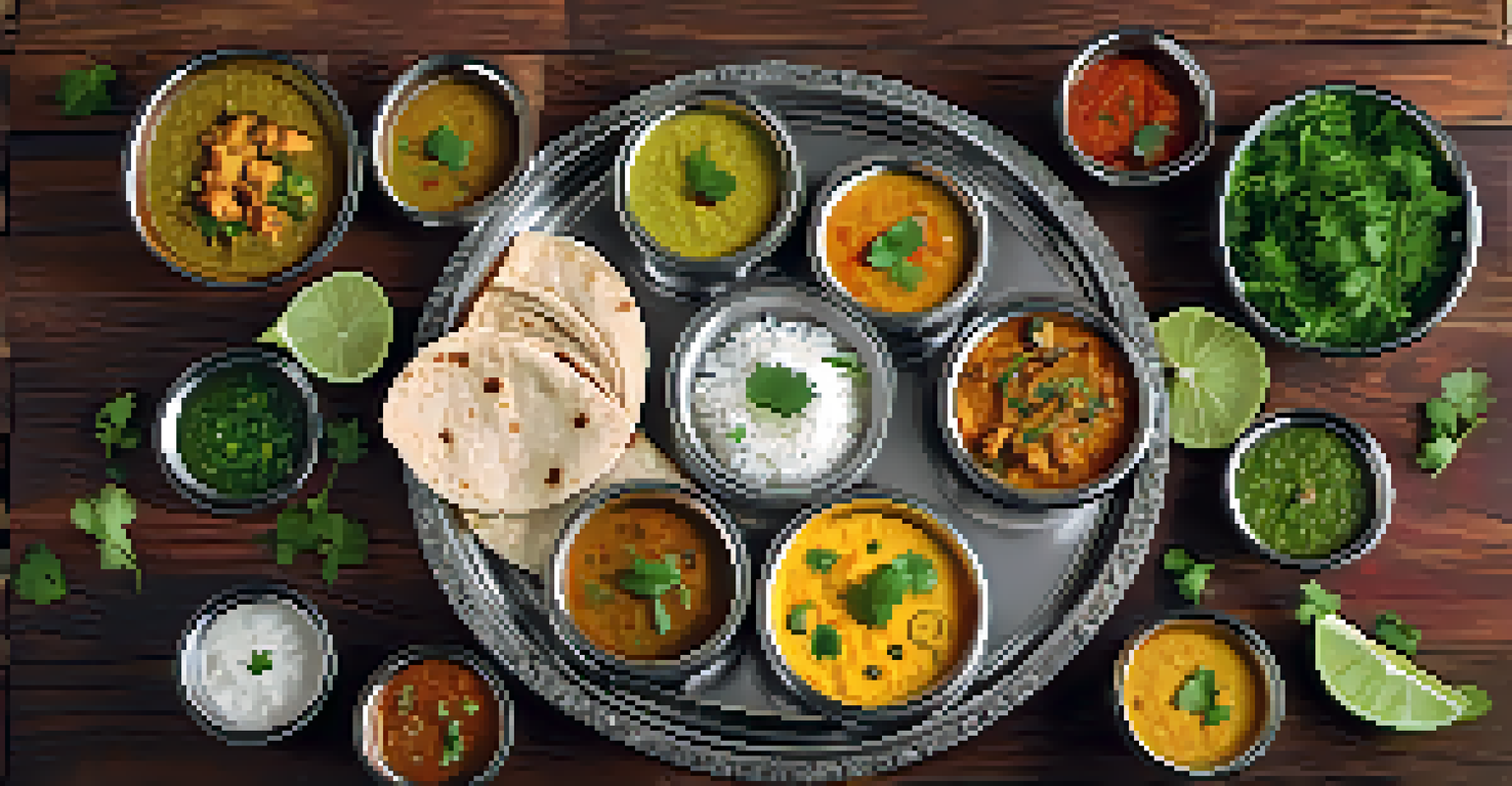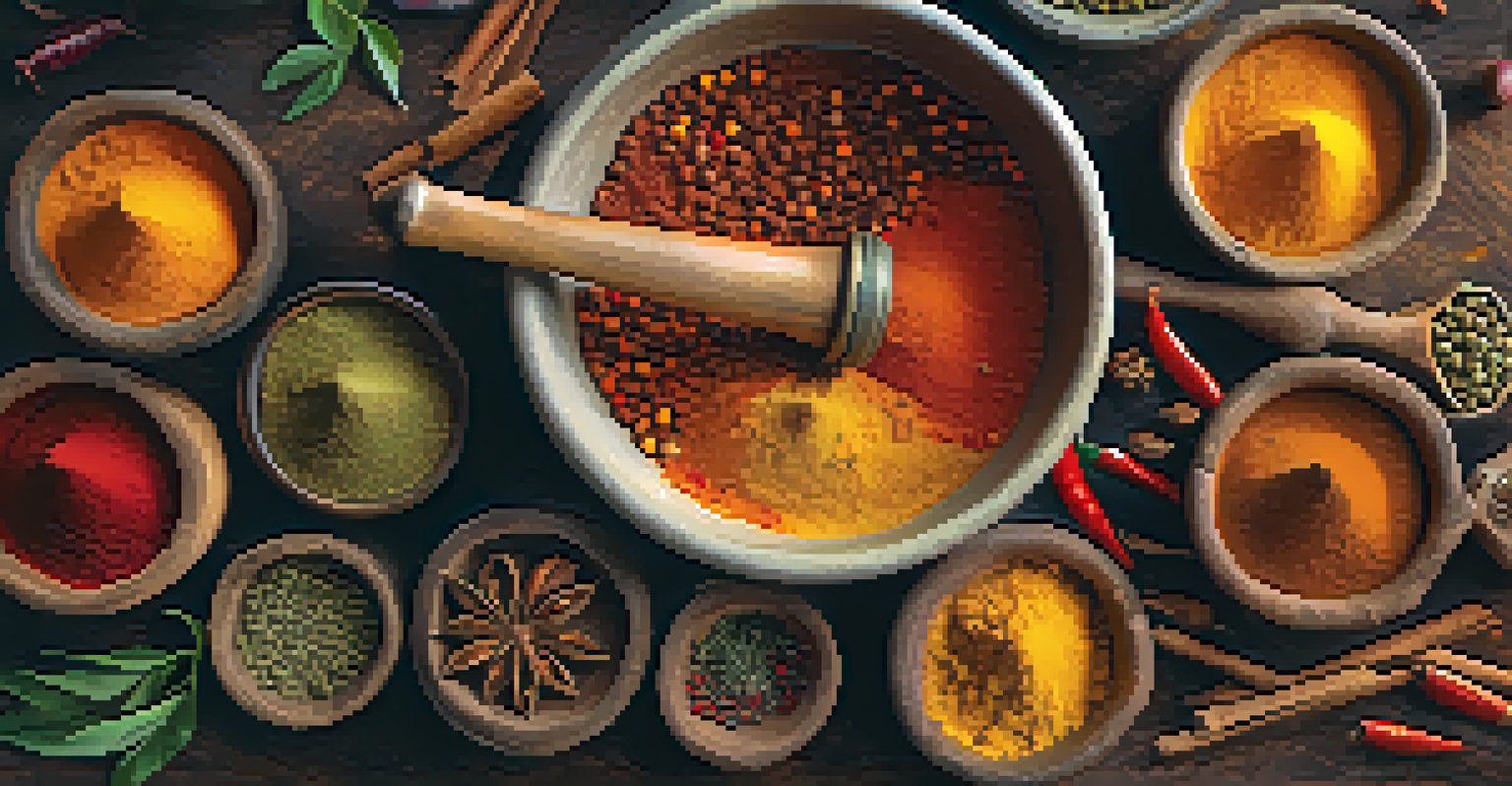Traditional Indian Cooking Techniques Passed Through Generations

The Essence of Traditional Indian Cooking
Traditional Indian cooking is not just about preparing meals; it's a celebration of culture and heritage. Each dish tells a story, often rooted in family traditions that have been passed down through generations. The essence lies in using fresh, local ingredients and time-honored methods that bring out authentic flavors.
Cooking is like love. It should be entered into with abandon or not at all.
For many families, cooking is a communal activity, a time to bond and share knowledge. Elders pass on their culinary skills to the younger generations, ensuring that recipes are preserved and cherished. This connection to the past enriches the cooking experience, making it more than just a task, but a ritual steeped in love and history.
In essence, traditional Indian cooking is a tapestry woven from regional influences, personal memories, and cultural significance. The warmth of home-cooked meals nurtures relationships and keeps traditions alive, ensuring that the heart of Indian cuisine continues to beat strong.
The Role of Spice Blending in Indian Cuisine
Spices are the soul of Indian cooking, and their blending is an art form that has been refined over centuries. Each spice carries its unique flavor and health benefits, making the perfect blend essential for creating authentic dishes. Families often have their secret mixes, passed down as treasured heirlooms, which add a personal touch to every meal.

For instance, the popular garam masala is a blend that varies from household to household, often reflecting regional tastes and individual preferences. This diversity in spice blending not only enhances the flavor but also contributes to the nutritional profile of the dishes. It's fascinating how a pinch of this and a dash of that can transform a simple meal into a culinary masterpiece.
Cooking as Cultural Heritage
Traditional Indian cooking is a celebration of culture and family, where each dish reflects personal histories and regional influences.
Moreover, the careful selection and proportion of spices tell a story of the cook's heritage and creativity. As the aroma of spices fills the air, it evokes memories and fosters connections, bridging generations through the shared experience of cooking and enjoying meals together.
Cooking Methods: From Clay Ovens to Slow Simmering
Traditional Indian cooking involves a variety of methods, each with its unique charm and purpose. Tandoori cooking, for example, utilizes a clay oven that imparts a distinct smoky flavor to meats and breads, a technique that dates back thousands of years. The art of slow simmering, on the other hand, allows spices to meld beautifully, creating deep, rich flavors that are the hallmark of Indian curries.
Food is symbolic of love when words are inadequate.
These methods are not just about technique; they are deeply intertwined with the cultural practices of different regions. For instance, the use of the 'dum' cooking technique, which involves sealing pots to trap steam, is prevalent in certain parts of India. This slow cooking method not only enhances flavors but also preserves the nutrients in the ingredients.
In essence, the variety of cooking methods reflects the diversity of Indian cuisine. Each technique carries its own story, contributing to a collective culinary heritage that is both rich and vibrant, ensuring that traditional practices are honored even in modern kitchens.
The Importance of Seasonal Ingredients
In traditional Indian cooking, the use of seasonal ingredients is paramount. This approach not only ensures the freshest flavors but also aligns with the natural cycles of agriculture. Families often have a deep connection to the land, knowing when to harvest and which ingredients to use for specific dishes throughout the year.
For example, during monsoon season, dishes often feature lentils and seasonal vegetables that are plentiful during that time. Similarly, summer brings an abundance of ripe fruits, which are used in refreshing salads and drinks. This seasonal awareness not only enhances the taste of the food but also promotes sustainability and supports local farmers.
Art of Spice Blending
The blending of spices is a treasured art in Indian cuisine, with each family's unique mix enhancing both flavor and nutritional value.
By embracing seasonal ingredients, traditional Indian cooking fosters a deeper appreciation for nature's bounty. It encourages cooks to be creative and intuitive, making the cooking process a dynamic experience that changes with the seasons, much like life itself.
The Role of Fermentation in Indian Cuisine
Fermentation is a cornerstone of many traditional Indian dishes, offering unique flavors and health benefits. Foods like dosa and idli are made from fermented rice and lentil batter, which not only enhances taste but also boosts digestibility and nutritional value. This ancient technique is a testament to the wisdom of our ancestors who understood the science behind food preparation.
Fermentation also plays a crucial role in preserving food, especially in regions where refrigeration was historically unavailable. Pickles, or 'achar', are a prime example, where vegetables are preserved in spices and oil, allowing families to enjoy seasonal produce throughout the year. These tangy, flavorful accompaniments are a staple at Indian meals, showcasing the creativity born from necessity.
Moreover, the process of fermentation adds a layer of complexity to dishes, making them not just sustenance but a culinary experience. The joy of sharing fermented foods, rich in flavor and history, brings families together, reminding us of the age-old traditions that continue to thrive.
Community and Cooking: A Shared Tradition
In many Indian cultures, cooking is a communal activity that fosters a sense of belonging and togetherness. Families gather in the kitchen, with each member contributing their skills, whether it's chopping vegetables or stirring a pot. This collaboration not only strengthens family bonds but also ensures that culinary traditions are passed down seamlessly.
Festivals and celebrations provide a unique opportunity for communities to come together through food. Special dishes are prepared for occasions, often featuring recipes that have been cherished for generations. The act of cooking as a community creates a sense of pride and continuity, linking the past with the present.
Community and Togetherness
Cooking is a communal activity in Indian culture that fosters connections and preserves culinary traditions across generations.
Ultimately, the communal aspect of cooking enhances the cultural fabric of Indian society. It is in these shared experiences that the richness of traditional Indian cooking truly shines, as families and communities come together to celebrate life, love, and the joy of good food.
Preserving Traditional Techniques in Modern Times
As the world becomes increasingly fast-paced, the challenge of preserving traditional Indian cooking techniques is more relevant than ever. Many families are striving to maintain these practices, often finding ways to incorporate them into their busy lives. This commitment to tradition not only honors their heritage but also enriches their culinary experiences.
Culinary schools and workshops are emerging, focusing on teaching these age-old methods to younger generations. By blending traditional skills with modern culinary techniques, chefs are finding innovative ways to keep these practices alive while appealing to contemporary tastes. This fusion of old and new ensures that the essence of traditional Indian cooking remains vibrant and relevant.

Ultimately, preserving traditional cooking techniques is about more than just recipes; it's about safeguarding a way of life. As families and communities continue to celebrate their culinary heritage, they create a lasting legacy that future generations will cherish and uphold.